Abstract
Saccadic eye movement recording was performed in 53 patients with non-compressive myelopathy. Twenty one patients (40%) had subclinical abnormalities of saccadic movement, supporting a diagnosis of probable multiple sclerosis. When used in addition to the measurement of visual evoked potentials and brainstem auditory evoked responses, the detection of subclinical abnormalities increased from 40% to 57%. The detection rate of abnormalities by saccadic eye movement recording was equal to that of visual evoked responses, but more than of brainstem auditory evoked responses. Prolonged latency of gaze was the most common saccadic latency abnormality detected. The majority of saccadic velocity abnormalities could be explained by disease in the medial longitudinal bundle. An unusual finding was that abduction velocity was increased in six patients. It is concluded that the simple measurement of saccadic eye movement is a valuable addition to other ancillary investigations for the diagnosis of multiple sclerosis. It also allows analysis of oculomotor function, commonly disordered in multiple sclerosis, but rarely investigated.
Full text
PDF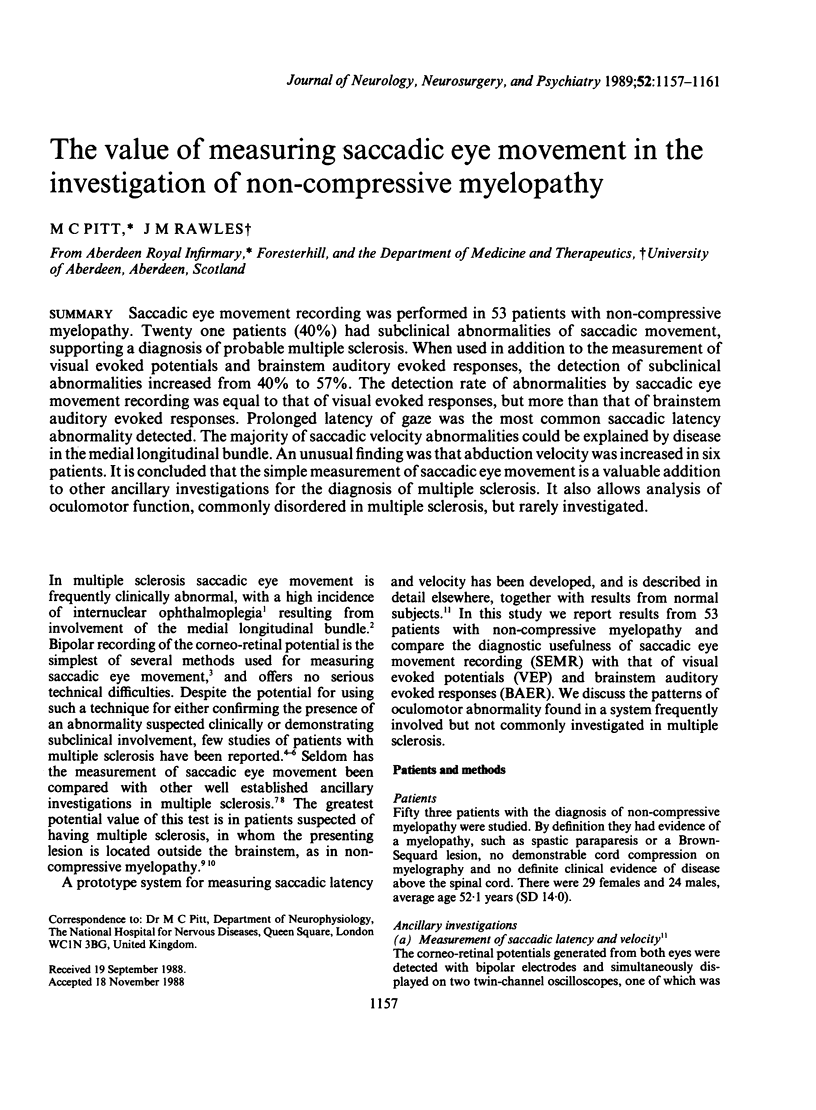
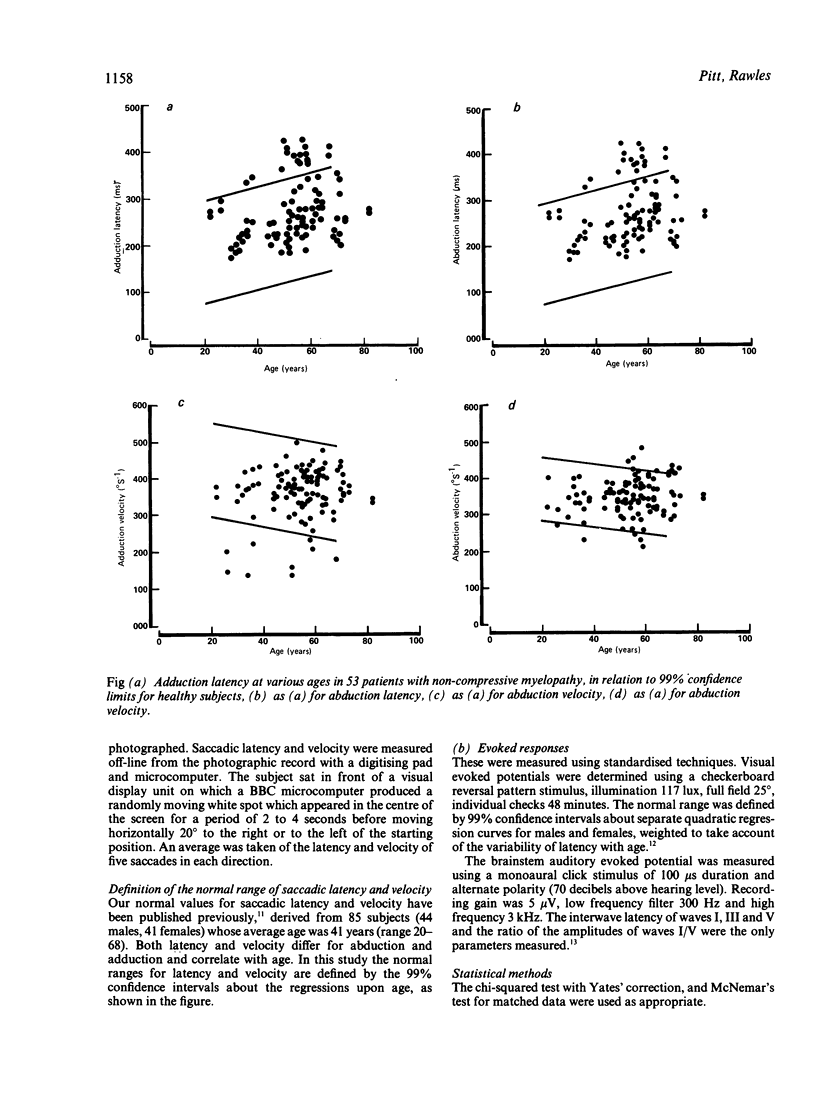
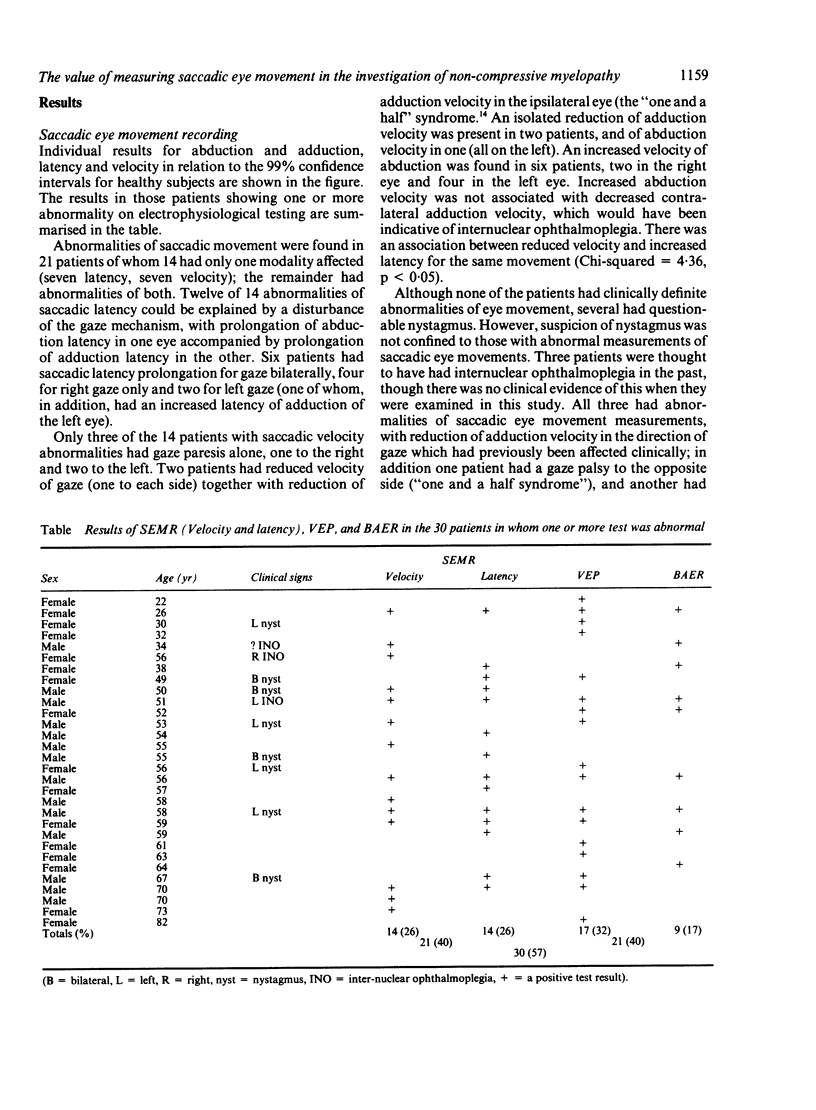
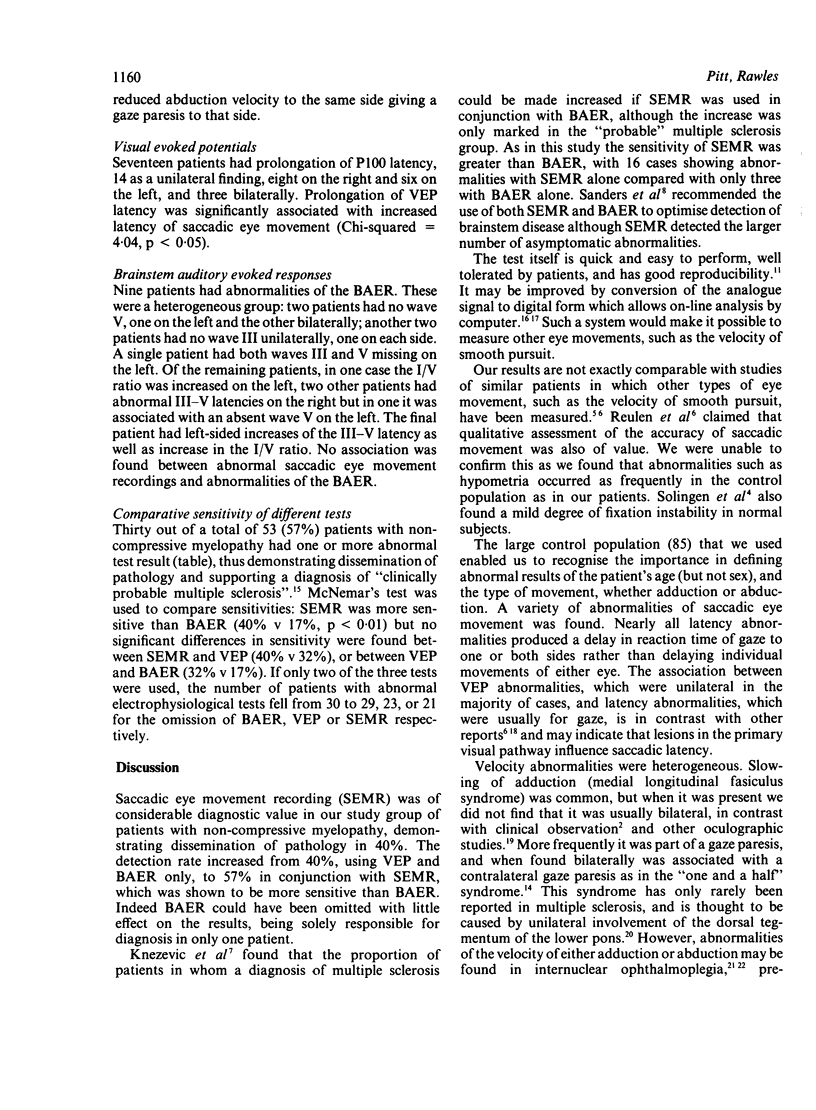
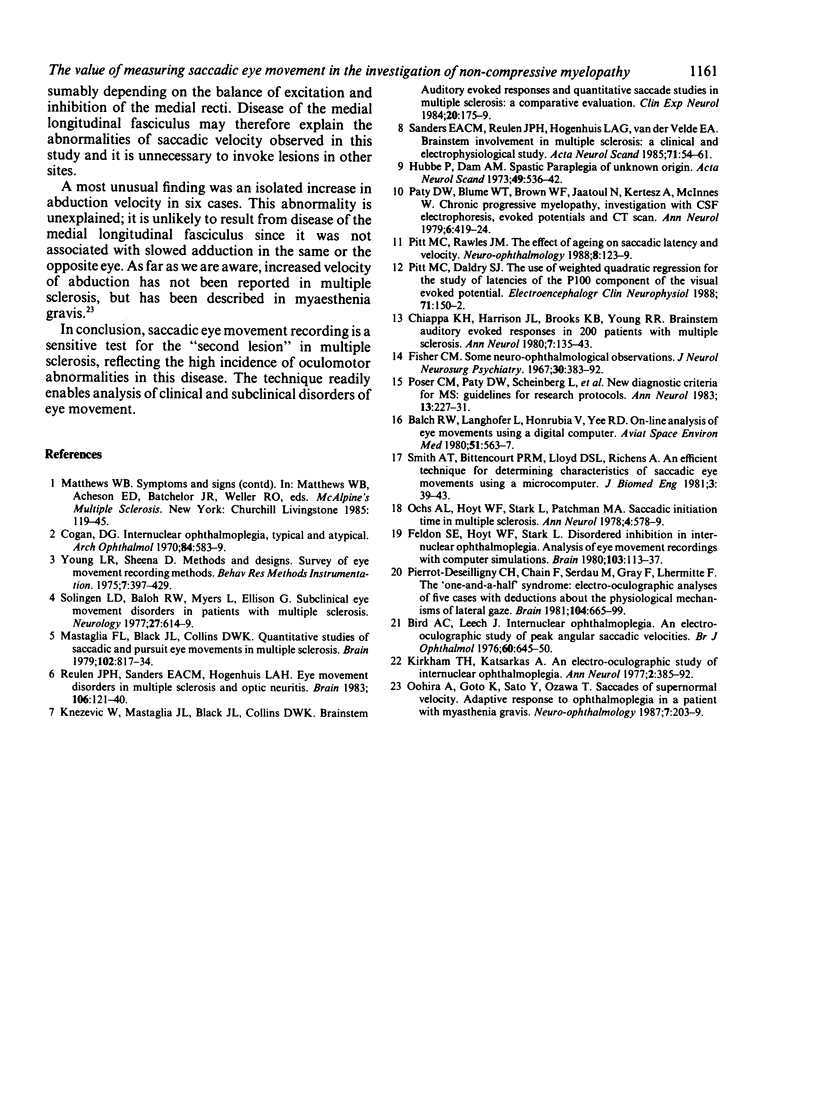
Selected References
These references are in PubMed. This may not be the complete list of references from this article.
- Baloh R. W., Langhofer L., Honrubia V., Yee R. D. On-line analysis of eye movements using a digital computer. Aviat Space Environ Med. 1980 Jun;51(6):563–567. [PubMed] [Google Scholar]
- Bird A. C., Leech J. Internuclear ophthalmoplegia. An electro-oculographic study of peak angular saccadic velocities. Br J Ophthalmol. 1976 Sep;60(9):645–651. doi: 10.1136/bjo.60.9.645. [DOI] [PMC free article] [PubMed] [Google Scholar]
- Chiappa K. H., Harrison J. L., Brooks E. B., Young R. R. Brainstem auditory evoked responses in 200 patients with multiple sclerosis. Ann Neurol. 1980 Feb;7(2):135–143. doi: 10.1002/ana.410070208. [DOI] [PubMed] [Google Scholar]
- Cogan D. G. Internuclear ophthalmoplegia, typical and atypical. Arch Ophthalmol. 1970 Nov;84(5):583–589. doi: 10.1001/archopht.1970.00990040585005. [DOI] [PubMed] [Google Scholar]
- Feldon S. E., Hoyt W. F., Stark L. Disordered inhibition in internuclear ophthalmoplegia: analysis of eye movement recordings with computer simulations. Brain. 1980 Mar;103(1):113–137. doi: 10.1093/brain/103.1.113. [DOI] [PubMed] [Google Scholar]
- Fisher C. M. Some neuro-ophthalmological observations. J Neurol Neurosurg Psychiatry. 1967 Oct;30(5):383–392. doi: 10.1136/jnnp.30.5.383. [DOI] [PMC free article] [PubMed] [Google Scholar]
- Hübbe P., Mouritzen Dam A. Spastic paraplegia of unknown origin. A follow-up of 32 patients. Acta Neurol Scand. 1973;49(4):536–542. doi: 10.1111/j.1600-0404.1973.tb01326.x. [DOI] [PubMed] [Google Scholar]
- Kirkham T. H., Katsarkas A. An electrooculographic study of internuclear ophthalmoplegia. Ann Neurol. 1977 Nov;2(5):385–392. doi: 10.1002/ana.410020507. [DOI] [PubMed] [Google Scholar]
- Knezevic W., Mastaglia F. L., Black J. L., Collins D. W. Brainstem auditory evoked responses and quantitative saccade studies in multiple sclerosis: a comparative evaluation. Clin Exp Neurol. 1984;20:175–179. [PubMed] [Google Scholar]
- Ochs A. L., Hoyt W. F., Stark L., Patchman M. A. Saccadic initiation time in multiple sclerosis. Ann Neurol. 1978 Dec;4(6):578–579. doi: 10.1002/ana.410040624. [DOI] [PubMed] [Google Scholar]
- Paty D. W., Blume W. T., Brown W. F., Jaatoul N., Kertesz A., McInnis W. Chronic progressive myelopathy: investigation with CSF electrophoresis, evoked potentials, and CT scan. Ann Neurol. 1979 Nov;6(5):419–424. doi: 10.1002/ana.410060508. [DOI] [PubMed] [Google Scholar]
- Pierrot-Deseilligny C., Chain F., Serdaru M., Gray F., Lhermitte F. The 'one-and-a-half' syndrome. Electro-oculographic analyses of five cases with deductions about the Physiological mechanisms of lateral gaze. Brain. 1981 Dec;104(Pt 4):665–699. doi: 10.1093/brain/104.4.665. [DOI] [PubMed] [Google Scholar]
- Pitt M. C., Daldry S. J. The use of weighted quadratic regression for the study of latencies of the P100 component of the visual evoked potential. Electroencephalogr Clin Neurophysiol. 1988 Mar-Apr;71(2):150–152. doi: 10.1016/0168-5597(88)90074-3. [DOI] [PubMed] [Google Scholar]
- Poser C. M., Paty D. W., Scheinberg L., McDonald W. I., Davis F. A., Ebers G. C., Johnson K. P., Sibley W. A., Silberberg D. H., Tourtellotte W. W. New diagnostic criteria for multiple sclerosis: guidelines for research protocols. Ann Neurol. 1983 Mar;13(3):227–231. doi: 10.1002/ana.410130302. [DOI] [PubMed] [Google Scholar]
- Reulen J. P., Sanders E. A., Hogenhuis L. A. Eye movement disorders in multiple sclerosis and optic neuritis. Brain. 1983 Mar;106(Pt 1):121–140. doi: 10.1093/brain/106.1.121. [DOI] [PubMed] [Google Scholar]
- Sanders E. A., Reulen J. P., Hogenhuis L. A., van der Velde E. A. Brainstem involvement in multiple sclerosis: a clinical and electrophysiological study. Acta Neurol Scand. 1985 Jan;71(1):54–61. doi: 10.1111/j.1600-0404.1985.tb03167.x. [DOI] [PubMed] [Google Scholar]
- Smith A. T., Bittencourt P. R., Lloyd D. S., Richens A. An efficient technique for determining characteristics of saccadic eye movements using a mini computer. J Biomed Eng. 1981 Jan;3(1):39–43. doi: 10.1016/0141-5425(81)90103-5. [DOI] [PubMed] [Google Scholar]
- Solingen L. D., Baloh R. W., Myers L., Ellison G. Subclinical eye movement disorders in patients with multiple sclerosis. Neurology. 1977 Jul;27(7):614–619. doi: 10.1212/wnl.27.7.614. [DOI] [PubMed] [Google Scholar]


